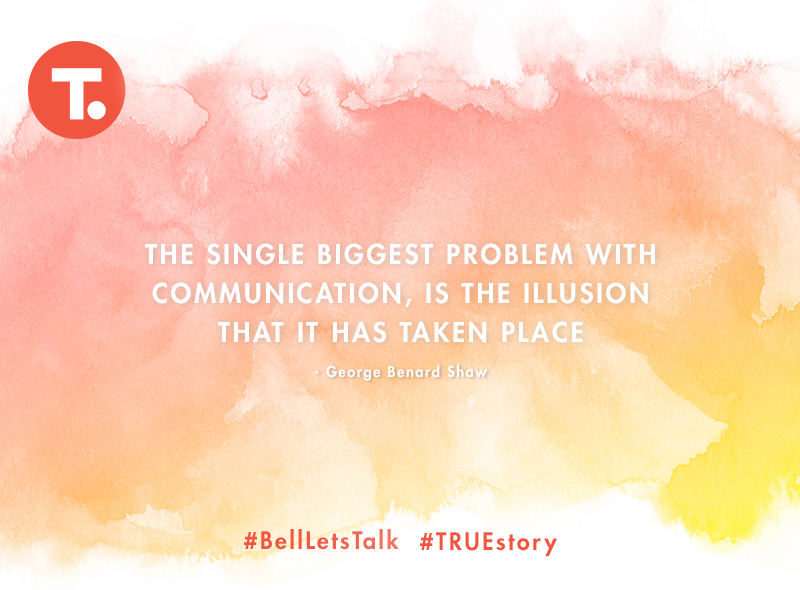Let’s Talk Strategies For Workplace Mental Health
Bell Let’s Talk Day has been a game changer for raising money for mental health, but the real victory is found in the conversations that are sparked. TRUEdotDESIGN, at its heart, is a communications company and it’s through branding and marketing initiatives that we translate our clients story and vision to their target audience. Communication matters! How many times have we heard that people don’t connect with a logo, they connect with people? This is why marketing has become so much more transparent, companies introducing you to their employees and showing what’s behind the scenes, so you can connect in a more personal way. But what if behind the glossy social media scenes, you have a group of people who are struggling to keep up? How transparent and authentic is that?

Developing strategies for dealing with mental health issues within an organization is not only ecological, it’s economical.
When people feel valued and valuable, and are given the resources and time they need to create a vibrant life, you will find that their productivity increases, sick days diminish and team loyalty becomes an intrinsic part of the culture.
Simple Strategies for Creating a Healthy Corporate Culture
- Encourage people to completely unplug on weekends and reserve email or texting after hours for actual emergencies.
- Make it easy for staff to schedule their vacation time and ensure that they feel supported in taking the time, as opposed to making them feel like they are making life difficult for their co-workers.
- Provide opportunities where people can connect to others and build friendships and support networks. This can be as simple as regular coffee breaks and collaborative lunch gatherings. Remember most employees spend more waking hours with their colleagues than their families, and for some, the workplace might be the only place they have the time for connection and engagement.
At TRUEdotDESIGN, we have a team of 13. Our days can be ridiculously busy and unpredictable, but I know I can count on my team to drop a coffee at my desk or share a glass of bubbly at the end of a long week (or Tuesday). I need these people. I frequently feel an instant jolt of relief by talking through an idea with a colleague, or sharing a story of a particularly difficult morning with my kids. I am grateful every day to be surrounded by people who show love and compassion and know when to laugh and when to hug. Today, I encourage you to reach out to friends, family and co-workers, share your story or listen to someone else’s, you never know how much people need what you can offer.
On Bell Let’s Talk Day, Bell will donate five cents for:
- Each text message you send on the Bell network.
- Every mobile and long distance call you make on their network.
- Individual tweets and retweets that use the hashtag #BellLetsTalk.
- Instagram posts using the hashtag #BellLetsTalk.
- Every time someone watches the Bell Let’s Talk video on Facebook.
- Each time a Snapchat snap is sent using the Bell Let’s Talk geofilter.
Be Prepared
- Have an iPhone? Turn off iMessage if you’re on Bell’s mobile network to make sure your texts are being counted.
- Schedule your #BellLetsTalk tweets using Tweetdeck or Hootsuite so that they all come out on January 25. And remember, the campaign is Canada-wide – thanks to our timezones, there are more than 24 hours to the day.
- Don’t be afraid to ask questions. Not everyone is a subject matter expert, and there are lots of people who are more than willing to provide explanations on even the most basic terms and concepts around mental illness.
- Follow reputable mental health organizations on social media for ideas on what you can share, and discover relevant content about mental health. (Get a headstart by visiting CAMH’s BLTD 2017 webpage.)
- Update your profile photo and cover image on Facebook and Twitter, even if just temporarily. It’s a good reminder to friends or followers who may not be up to speed on the importance of mental health awareness (or are really bad with remembering dates).
- Use the quote retweet function on Twitter to provide your perspective on a retweet.
- Get together with friends, family, coworkers and classmates to actually discuss mental health in person in an open-minded, supportive and understanding way. Social media may be where the donations are coming in, but lunchroom, water cooler or dinner table discussions will allow people to share personal insights on mental health.
Thank you, to The Centre for Addiction and Mental Health for the list above. Read their full blog post: click here.

